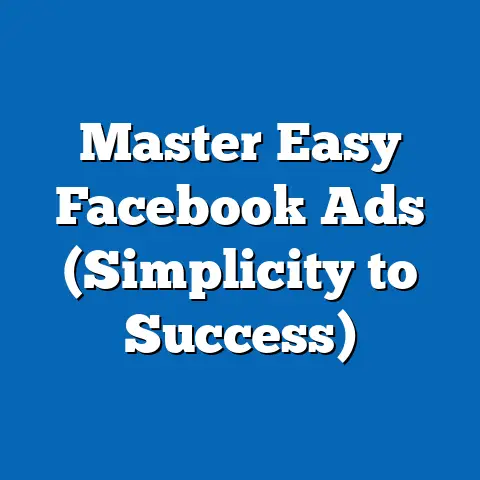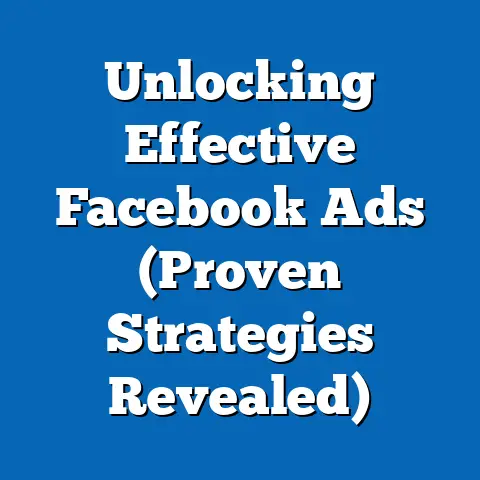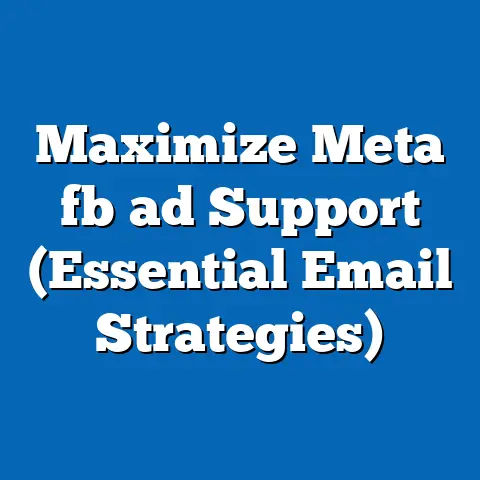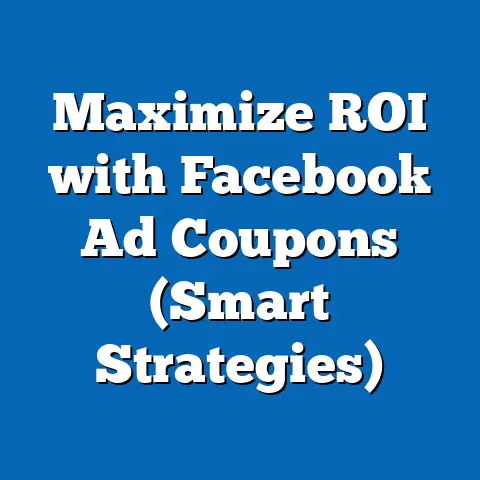Boost CPM Strategies for Facebook Ads 2025 (Insider Tips)
In the world of Facebook advertising, there’s a seeming paradox: the more you spend on CPM (Cost Per Mille), the less you seem to reach your target audience. It’s a frustrating experience I’ve seen countless times, both in my own campaigns and with clients. You’re throwing money at the platform, but the results just aren’t there. Yet, those who master the art of strategic spending find themselves reaping rewards that far exceed their initial investments. They understand that CPM isn’t just a cost; it’s an investment in visibility, and when done right, it can drive massive growth.
This article is your guide to unlocking that potential. We’ll delve into the world of CPM, dissecting its complexities and revealing insider tips that will help you maximize its effectiveness in 2025. I’m not just going to give you theoretical advice; I’ll share practical strategies and real-world examples that you can implement immediately. Get ready to transform your Facebook ad campaigns and achieve the results you deserve.
Understanding CPM: The Basics and Beyond
Let’s start with the fundamentals. CPM, or Cost Per Mille (Mille is Latin for thousand), represents the cost you pay for one thousand impressions of your ad. In simpler terms, it’s how much you’re charged each time your ad is shown to a thousand people. Think of it like buying advertising space in a magazine – you pay a certain amount to have your ad seen by a specific number of readers.
But CPM is more than just a number. It’s a crucial metric that reflects the efficiency of your advertising campaigns. A high CPM might indicate that you’re targeting a competitive audience, your ad creative isn’t resonating, or your ad placement isn’t optimal. Conversely, a low CPM could signal that you’re reaching a less desirable audience or that your ad is being shown in low-quality placements.
Several factors influence CPM rates on Facebook:
- Audience Targeting: Highly specific and competitive audiences tend to have higher CPMs. For example, targeting affluent professionals in a major city will likely cost more than targeting a broader demographic in a smaller town.
- Ad Placement: Where your ad is shown (e.g., Facebook News Feed, Instagram Stories, Audience Network) significantly impacts CPM. Placements with higher visibility and engagement typically command higher rates.
- Ad Quality and Relevance: Facebook rewards ads that are relevant and engaging to users. A high-quality ad with a good relevance score will often have a lower CPM than a poorly designed or irrelevant ad.
- Competition: The more advertisers vying for the same audience, the higher the CPM. Seasonal trends, major events, and industry-specific campaigns can all drive up competition and CPM rates.
- Bidding Strategy: While we’re focusing on CPM, the bidding strategy you choose still plays a role. Facebook’s algorithm considers your overall campaign goals and budget when determining which ads to show.
It’s also important to understand how CPM differs from other bidding strategies like CPC (Cost Per Click) and CPA (Cost Per Acquisition). CPC charges you for each click your ad receives, while CPA charges you for each conversion (e.g., purchase, sign-up) your ad generates.
So, when is it advantageous to use CPM?
- Brand Awareness Campaigns: If your primary goal is to increase brand visibility and reach a large audience, CPM can be a cost-effective option. You’re paying for impressions, not necessarily clicks or conversions.
- Promoting Visual Content: Ads with strong visual elements, like videos or high-quality images, can benefit from CPM bidding. The goal is to capture attention and leave a lasting impression, even if users don’t click.
- Retargeting Campaigns: When retargeting users who have already interacted with your brand, CPM can be effective in keeping your brand top-of-mind.
Key Takeaway: CPM is a fundamental metric in Facebook advertising that reflects the cost of reaching a thousand people with your ad. Understanding the factors that influence CPM rates and how it differs from other bidding strategies is crucial for optimizing your campaigns.
The Evolving Landscape of Facebook Advertising in 2025
The Facebook advertising landscape is constantly evolving, and 2025 promises to bring even more changes. To effectively boost your CPM strategies, you need to stay abreast of these trends and adapt your approach accordingly.
One of the most significant shifts is the increasing emphasis on user privacy. Facebook has been under pressure to protect user data, leading to changes in advertising policies and data tracking capabilities. This means that advertisers need to rely more on first-party data and build stronger relationships with their customers.
Another key trend is the rise of artificial intelligence (AI) and machine learning (ML). Facebook is increasingly using AI and ML to optimize ad delivery, improve targeting, and personalize ad experiences. Advertisers who leverage these technologies will have a significant advantage in reaching their target audiences and achieving their campaign goals.
User behavior is also evolving. People are spending more time on mobile devices, consuming video content, and engaging with interactive ad formats. Advertisers need to create mobile-first, video-centric ads that capture attention and encourage interaction.
Let’s look at some data and statistics on CPM trends:
- Average CPM rates on Facebook have been steadily increasing in recent years. This is due to a combination of factors, including increased competition, higher ad quality standards, and changes in Facebook’s algorithm.
- CPM rates vary significantly depending on the industry, audience, and ad placement. For example, CPMs in the e-commerce industry tend to be higher during the holiday season due to increased competition.
- Experts predict that CPM rates will continue to rise in 2025. This means that advertisers need to be even more strategic in their approach to CPM and focus on optimizing their campaigns for maximum efficiency.
In my experience, the key to navigating these changes is to stay flexible and adaptable. Don’t be afraid to experiment with new ad formats, targeting options, and bidding strategies. Continuously monitor your campaign performance and make adjustments as needed. The advertisers who are willing to embrace change and innovate will be the ones who succeed in the evolving Facebook advertising landscape.
Key Takeaway: The Facebook advertising landscape is constantly evolving, with increasing emphasis on user privacy, the rise of AI and ML, and changing user behavior. Staying informed about these trends and adapting your strategies accordingly is crucial for boosting your CPM effectiveness in 2025.
Insider Tip #1: Precision in Audience Targeting
One of the most effective ways to lower your CPM is to laser-focus your audience targeting. The more relevant your ads are to the people who see them, the higher your ad quality score will be, and the lower your CPM will be. It’s a win-win situation.
Think of it like this: if you’re selling vegan protein powder, you don’t want to show your ads to meat-eaters. You want to target vegans, vegetarians, and people who are interested in healthy eating and fitness. By narrowing your focus, you’ll reach a more receptive audience and reduce wasted impressions.
Facebook offers a range of powerful tools for defining and refining your target audiences:
- Custom Audiences: These allow you to target people based on your own data, such as email lists, website visitors, and app users. This is a great way to retarget existing customers or reach people who have already shown interest in your brand. I’ve used custom audiences to re-engage website visitors who abandoned their shopping carts, resulting in a significant increase in conversions.
- Lookalike Audiences: These allow you to create new audiences that are similar to your existing customers or website visitors. Facebook uses its algorithm to identify people who share similar demographics, interests, and behaviors with your source audience. Lookalike audiences can be a powerful way to expand your reach and find new customers.
- Detailed Targeting: This allows you to target people based on their demographics, interests, behaviors, and connections. You can use detailed targeting to narrow your audience based on factors like age, gender, location, education, job title, interests, hobbies, and more.
Here are some strategies for effective audience targeting:
- Start with a broad audience and gradually narrow it down. Use Facebook’s audience insights tool to identify the demographics, interests, and behaviors that are most relevant to your product or service.
- Create separate ad sets for different audience segments. This allows you to tailor your ad creative and messaging to each segment, increasing relevance and engagement.
- Use A/B testing to experiment with different targeting options. Test different demographics, interests, and behaviors to see which ones perform best.
- Regularly review and refine your audience targeting. As your business evolves and your target audience changes, you need to update your targeting accordingly.
Case Study: A local bakery wanted to increase its sales of custom cakes. They created a custom audience of people who had visited their website in the past 30 days and a lookalike audience based on that custom audience. They then created a series of ads showcasing their custom cake designs and targeted them to these audiences. As a result, they saw a significant increase in custom cake orders and a decrease in their CPM.
Key Takeaway: Precision in audience targeting is crucial for lowering your CPM. By using Facebook’s targeting tools effectively and continuously refining your audience, you can reach the right people with the right message at the right time.
Insider Tip #2: Creative Ad Content that Captivates
The quality of your ad creative plays a significant role in influencing CPM rates. Ads that are visually appealing, engaging, and relevant to the target audience tend to have higher click-through rates (CTR) and lower CPMs.
Think about it: people are bombarded with ads every day. To stand out from the crowd, your ads need to grab their attention and pique their interest. They need to be visually appealing, relevant to their interests, and offer something of value.
Here are some tips on creating ad content that captivates:
- Use high-quality images and videos. Visuals are the first thing people see, so make sure they’re eye-catching and professional. Use high-resolution images and videos that are well-lit and in focus.
- Tell a story. People are drawn to stories, so use your ad copy and visuals to tell a compelling story that resonates with your target audience.
- Highlight the benefits, not just the features. Focus on how your product or service will solve your customers’ problems and improve their lives.
- Use a clear and concise call to action. Tell people exactly what you want them to do, whether it’s visiting your website, making a purchase, or signing up for a newsletter.
- A/B test different creatives. Experiment with different images, videos, headlines, and ad copy to see what performs best.
When I’m creating ad content, I always start by thinking about my target audience. What are their pain points? What are their aspirations? What kind of content do they enjoy consuming? Once I have a clear understanding of my audience, I can create ads that speak directly to their needs and interests.
A/B testing is also essential. Don’t assume that you know what will work best. Test different variations of your ads to see which ones resonate most with your audience. You might be surprised at the results.
Example: A clothing retailer wanted to promote its new line of summer dresses. They created two different ads: one featuring a model wearing a dress on a beach and another featuring a collage of different dresses. They A/B tested the two ads and found that the collage ad performed much better, resulting in a higher CTR and a lower CPM.
Key Takeaway: Creative ad content is essential for influencing CPM rates. By creating visually appealing, engaging, and relevant ads, you can capture attention, increase click-through rates, and lower your CPM.
Insider Tip #3: Timing is Everything
The timing of your ad campaigns can have a significant impact on your CPM. By strategically scheduling your ads to run during peak usage times and seasonal trends, you can maximize your reach and minimize your CPM.
Think about it: people are more likely to be on Facebook at certain times of the day and during certain times of the year. If you run your ads when more people are online and engaged, you’ll reach a larger audience and potentially lower your CPM.
Here are some strategies for optimizing your ad timing:
- Identify peak usage times. Use Facebook’s audience insights tool to determine when your target audience is most active on the platform.
- Schedule your ads to run during peak usage times. Use Facebook’s ad scheduling feature to schedule your ads to run during the times when your audience is most likely to see them.
- Take advantage of seasonal trends. Promote products or services that are relevant to specific seasons or holidays. For example, you might promote winter coats in the fall or summer dresses in the spring.
- Run time-sensitive promotions. Create a sense of urgency by running promotions that are only available for a limited time. This can encourage people to take action and increase your ad engagement.
I’ve found that the best times to run ads vary depending on the industry and target audience. For example, ads for restaurants might perform best during lunch and dinner hours, while ads for fitness products might perform best in the morning or evening.
It’s also important to consider seasonal trends. For example, retailers often see a surge in sales during the holiday season, so they might want to increase their ad spend during that time.
Tools and Analytics: Facebook provides a range of tools and analytics that can help you determine the best times to run your ads. You can use the audience insights tool to identify peak usage times and the ad reporting tool to track the performance of your ads at different times of the day.
Example: A coffee shop wanted to increase its sales of iced coffee during the summer months. They scheduled their ads to run during the hottest hours of the day and targeted them to people who were interested in coffee and summer activities. As a result, they saw a significant increase in iced coffee sales and a decrease in their CPM.
Key Takeaway: Timing is everything when it comes to Facebook advertising. By strategically scheduling your ads to run during peak usage times and seasonal trends, you can maximize your reach and minimize your CPM.
Insider Tip #4: Leveraging Retargeting Strategies
Retargeting is a powerful strategy for improving ad performance and reducing CPM. By retargeting users who have already interacted with your brand, you can show them ads that are more relevant and engaging, leading to higher click-through rates and lower CPMs.
Think about it: people who have already visited your website, watched your videos, or engaged with your social media posts are more likely to be interested in your products or services. By retargeting these users, you can keep your brand top-of-mind and encourage them to take the next step.
Here are some actionable steps for setting up effective retargeting campaigns on Facebook:
- Install the Facebook Pixel on your website. The Facebook Pixel is a piece of code that tracks user activity on your website. It allows you to create custom audiences of people who have visited specific pages, added items to their cart, or made a purchase.
- Create custom audiences based on website activity. Use the Facebook Pixel to create custom audiences of people who have visited your website in the past 30, 60, or 90 days. You can also create custom audiences of people who have visited specific pages, such as your product pages or blog posts.
- Create custom audiences based on app activity. If you have a mobile app, you can use the Facebook SDK to track user activity within your app. This allows you to create custom audiences of people who have downloaded your app, used specific features, or made in-app purchases.
- Create custom audiences based on video views. If you’re using video ads, you can create custom audiences of people who have watched a certain percentage of your videos. This is a great way to retarget people who have shown interest in your brand’s content.
- Create dynamic product ads. Dynamic product ads allow you to automatically show users ads for the products they’ve viewed on your website. This is a highly effective way to retarget users who have abandoned their shopping carts or shown interest in specific products.
Example: An e-commerce store wanted to retarget users who had abandoned their shopping carts. They created a custom audience of people who had added items to their cart but didn’t complete the purchase. They then created a dynamic product ad that showed these users the exact products they had left in their cart. As a result, they saw a significant increase in recovered sales and a decrease in their CPM.
Key Takeaway: Retargeting is a powerful strategy for improving ad performance and reducing CPM. By retargeting users who have already interacted with your brand, you can show them ads that are more relevant and engaging, leading to higher click-through rates and lower CPMs.
Insider Tip #5: Utilizing Facebook’s Ad Auction System
Understanding how the Facebook ad auction works is crucial for optimizing your bids and minimizing your CPM. Facebook’s ad auction is a complex system that determines which ads are shown to which users and at what price.
Here’s a breakdown of how the Facebook ad auction works:
- Advertisers set their bids. Advertisers specify how much they’re willing to pay for each impression, click, or conversion.
- Facebook evaluates the ads. Facebook considers several factors, including the advertiser’s bid, ad quality, and relevance to the user.
- Facebook selects the winning ads. Facebook selects the ads that are most likely to achieve the advertiser’s goals while providing a positive experience for the user.
- Advertisers pay for the results. Advertisers pay for the impressions, clicks, or conversions they receive, based on their chosen bidding strategy.
One of the most important factors in the ad auction is the Quality Score. This is a metric that reflects the overall quality and relevance of your ad. A high Quality Score can lead to lower CPMs and better ad placement.
Here are some strategies for optimizing your bids and understanding competition within the ad auction:
- Use automated bidding strategies. Facebook offers several automated bidding strategies, such as lowest cost and target cost, that can help you optimize your bids and achieve your campaign goals.
- Monitor your ad performance closely. Track your CPM, CTR, and conversion rates to see how your ads are performing and make adjustments as needed.
- Research your competition. Use Facebook’s ad library to see what ads your competitors are running and how they’re targeting their audiences.
- Experiment with different bidding strategies. Test different bidding strategies to see which ones work best for your campaigns.
Example: A small business wanted to increase its brand awareness but had a limited budget. They used Facebook’s automated bidding strategy to optimize their bids and reach as many people as possible within their budget. As a result, they saw a significant increase in brand awareness and a decrease in their CPM.
Key Takeaway: Understanding how the Facebook ad auction works is crucial for optimizing your bids and minimizing your CPM. By focusing on ad quality, relevance, and strategic bidding, you can improve your chances of winning the ad auction and achieving your campaign goals.
Insider Tip #6: Continuous Monitoring and Adjustment
The most successful Facebook advertisers are those who continuously monitor their ad performance and make adjustments as needed. The Facebook advertising landscape is constantly changing, so it’s essential to stay on top of your campaigns and adapt your strategies accordingly.
Here are some key performance indicators (KPIs) to watch for optimizing CPM:
- CPM (Cost Per Mille): This is the cost you pay for one thousand impressions of your ad.
- CTR (Click-Through Rate): This is the percentage of people who see your ad and click on it.
- Relevance Score: This is a metric that reflects the overall quality and relevance of your ad.
- Conversion Rate: This is the percentage of people who click on your ad and complete a desired action, such as making a purchase or signing up for a newsletter.
- ROAS (Return on Ad Spend): This is the amount of revenue you generate for every dollar you spend on advertising.
Here are some tools available for tracking and adjusting ad campaigns in real-time:
- Facebook Ads Manager: This is the primary tool for creating, managing, and tracking your Facebook ad campaigns.
- Facebook Analytics: This tool provides detailed insights into user behavior on your website and app.
- Third-party analytics tools: There are several third-party analytics tools that can provide additional insights into your ad performance.
Here are some tips for ongoing analysis of ad performance metrics:
- Set clear goals and objectives. Before you start running your ads, define what you want to achieve.
- Track your KPIs regularly. Monitor your KPIs on a daily or weekly basis to see how your ads are performing.
- Identify trends and patterns. Look for trends and patterns in your data to see what’s working and what’s not.
- Make adjustments as needed. Based on your analysis, make adjustments to your ad targeting, creative, and bidding strategies.
Example: A clothing retailer was running a Facebook ad campaign to promote its new line of summer dresses. They noticed that their CPM was increasing, but their CTR and conversion rate were declining. After analyzing their data, they realized that their ad creative was no longer resonating with their target audience. They created a new ad with a different image and ad copy, and their CPM decreased, while their CTR and conversion rate increased.
Key Takeaway: Continuous monitoring and adjustment are essential for optimizing CPM and achieving your campaign goals. By tracking your KPIs regularly, identifying trends and patterns, and making adjustments as needed, you can ensure that your ads are performing at their best.
Conclusion: The Future of CPM Strategies on Facebook
We’ve covered a lot of ground in this guide, from understanding the basics of CPM to exploring advanced strategies for boosting its effectiveness in 2025. We’ve discussed the importance of precision in audience targeting, creative ad content, strategic timing, retargeting, and continuous monitoring.
The key takeaways are clear:
- CPM is a dynamic metric that requires constant attention and optimization.
- The Facebook advertising landscape is constantly evolving, so it’s essential to stay informed and adapt your strategies accordingly.
- By focusing on relevance, engagement, and strategic bidding, you can minimize your CPM and maximize your ROI.
As the Facebook advertising landscape continues to evolve, it’s crucial to stay ahead of the curve and embrace new technologies and strategies. The advertisers who are willing to experiment, innovate, and continuously learn will be the ones who succeed in the long run.
So, as you move forward into 2025 and beyond, remember the insider tips we’ve discussed in this guide. Use them to transform your Facebook ad campaigns and achieve the results you deserve. The future of CPM strategies on Facebook is bright, and with the right approach, you can unlock its full potential and drive massive growth for your business. I’m confident that by implementing these strategies, you’ll be well on your way to mastering the art of strategic spending and reaping the rewards that far exceed your initial investments. Now, go out there and make it happen!






